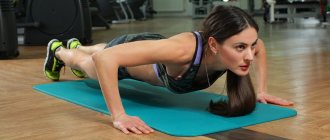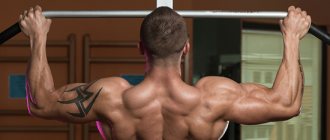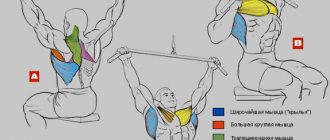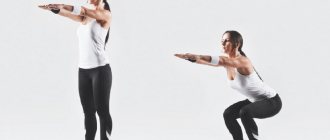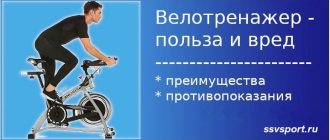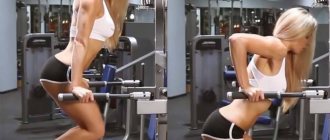The benefits of parallel bars training
It has been proven that the bench press is a less effective exercise in terms of muscle load than the parallel bars. What do the bars swing? If we go back several decades, they acted as the basic exercise machine for pumping up the pectoral muscles. However, the development of the industry for the production of new types of sports equipment has somewhat reduced interest in this projectile.
Why did athletes decide to abandon simpler and at the same time effective strength exercises in favor of innovation? It's all about the reputation of parallel bars as one of the most dangerous exercise machines.
Generally speaking, for practicing on the uneven bars, neither insurance nor observers are required. Training perfectly develops the outer and lower areas of the pectoral muscles. Regular training on the uneven bars allows you to feel a noticeable effect in a very short time.
Variations of the exercise
There are several ways to perform dips. By doing one or another variation of the exercise, it is possible to shift the emphasis to a specific muscle group. In order to comprehensively engage all the muscles involved in push-ups, it is recommended to alternate methods rather than focus on one.
Effective triceps workout
When doing push-ups on the uneven bars, your gaze should be directed forward or directed to the floor, and your neck should not deviate to the side, and your body should not sway.
The exercise should be done as follows:
- Take the starting position. The body is at the top point, arms are straightened.
- Slowly lower yourself, bending your elbows. Ideally, the shoulder and forearm should form a right angle.
- Stay in this position for a couple of seconds and raise your body.
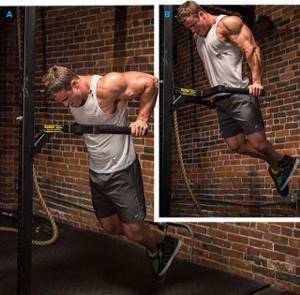
Do several repetitions.
Working out the pectoral muscles
If you change the position, you can move the main load from the triceps and use the pectoral muscles more. To do this, you need to tilt your body forward a little, and lower your body down deeper than in the previous version of the exercise. It is recommended to use wide bars so that your hands are placed at a distance greater than shoulder width.
In general, the dip-up technique for effectively working the pectoral muscles comes down to the following:
- Take the starting position. Grasp the bars with your hands, press your chin to your chest, cross your legs, bend your knees. Tilt the body slightly forward.
- Slowly lower yourself to the maximum possible depth, spreading your elbows at an angle of 45 degrees relative to your body.
- Stay in this position for a while and slowly raise your body. At the same time, at the top point the arms should not be completely straightened, otherwise the main load will shift to the triceps.
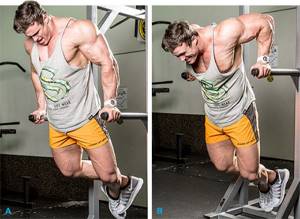
Do the required number of repetitions.
Dips with weights
Beginners should not do push-ups on uneven bars with weights. This exercise can be performed only after practicing the classic circuit with your own weight.
Special vests, belts and other devices can be used as weighting material. The main goal is to make the load larger and thereby increase the effectiveness of the exercise.
The execution technique is no different from previous versions. Depending on which muscle groups need to be worked, the exercise is performed in the first or second way.
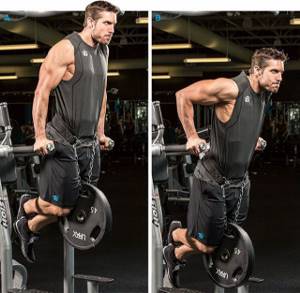
On a note! It is important to note that the lowest point is the most dangerous, so maximum care must be taken when lowering the body. You need to start with a light weight, increasing the load gradually.
Push-ups on the machine
In the gym, athletes can use a simulator, which is an excellent alternative to parallel bars equipped on the street. These push-ups differ from standard push-ups in that they have a counterweight. This version of the exercise is much easier to perform, so it is suitable for beginners. It is also where unprepared girls who want to strengthen their hands try to start.
In this case, the triceps and biceps are actively worked out. As for the pectoral muscles, the load on them is less. First of all, you will have to set the desired weight.
You need to do the exercise as follows:
- Grab the handrails with your hands, cross your legs, and place the wheel on a special step. It is important that your elbows form a right angle.
- Bend the body back and bring the shoulder blades closer to each other as far as possible. Raise your body. At the same time, the arms are straightened.
- Stay for a moment and take the starting position.
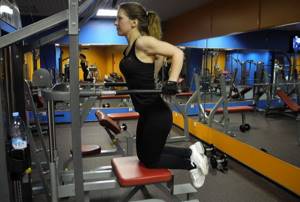
Repeat the required number of times.
In essence, these are regular push-ups, only performed in reverse order. The exercise is made easier by a special step, which serves as a support for the legs.
Features of the exercises
As noted above, it is the parallel bars that carry a considerable risk of injury. What such exercise machines pump up are the abs, pectoral muscles, biceps, triceps, as well as a whole host of other small muscles of the body. However, it is worth noting that you can only get injured on the uneven bars if you use the wrong technique for doing the exercises.
Before you begin active regular training on the uneven bars, you should familiarize yourself with the following requirements:
- It is necessary to start the lesson from the upper support, which allows the muscles to fully tone up and prepare for work.
- When lowering, the torso should be tilted slightly forward, because in a vertical position the main load will fall only on the triceps.
- Legs should be bent at the knees with ankles crossed. This approach to performing exercises greatly simplifies keeping the body in an inclined position.
- It is better to rest your chin on your chest, maintaining this position until the end of the approach.
- When lowering, bend your elbows until your wrist joint is in line with your armpits. In this case, it is necessary to carry out the descent slowly. Quick jerks when reaching the top position are fraught with injuries to the pectoral muscles.
- After taking a short pause while lowering, you must return to the starting position evenly and slowly.
Execution technique
To quickly get the desired result from push-ups, you need to adhere to the correct technique. In the classic version, the exercise should look like this:
- Grab the bars with your hands at a comfortable distance. Palms turned towards the body. The chin is pressed to the chest. The legs are crossed and the shoulders are pulled back.
- Place the main weight on your hands and, inhaling through your nose, slowly lower your body down. The shoulder blades are brought together, the back is straight. The elbow joint forms a right angle.
- Stay in this position for a couple of seconds.
- Exhale through your mouth and slowly raise your body.
Abs workout
What do dips do? Primarily the chest muscles. Despite this, parallel bars can be an excellent exercise machine for working your abdominal muscles. The most common exercise on the parallel bars for training the abs is the “corner”. The main task here is to rest your hands on the bars, lifting your knees up to your chest and lowering them down. During each approach, you should try to fix your knees in the upper position for some time. You can perform the “corner” exercise not only on the uneven bars, but also on the horizontal bar. However, it is the first option that is more powerful.

You can pump up your abs on parallel bars by lifting your legs. Despite the obvious simplicity of the exercise, it is quite difficult to do, especially without any preparation. To perform the exercise, it is enough to rest your hands on the bars while simultaneously raising both legs above the level of the bars, spreading them to the sides. If desired, this exercise can be somewhat diversified by alternately moving your legs in one direction or the other over the right and left crossbar.
Another effective exercise on the parallel bars for pumping up the abdominal muscles is raising the torso. To perform it, you need to sit on one of the bars, hooking your legs behind the other. Sitting on the uneven bars in this way, you should lower your torso as low as possible, trying not to sag in your back. As a result of proper execution, the abdominal muscles will always remain fully tense.
Controversial issue
Exercises on the horizontal bar and parallel bars for the abdominal muscles are almost identical, but disputes between athletes do not subside. It is believed that on the crossbar, due to stronger stretching of the muscles in the hanging position, the abs are better worked out. And the absence of bars on the sides allows you to increase the load by performing crowding. On the other hand, not every person is able to hold on to the horizontal bar in a hanging position on their hands, while also swinging during the exercise.
And without controversy, it is clear that it is easier to perform exercises on the uneven bars. Which muscles work in this case and under what load is the second question, the main thing is convenience. However, you don’t need to create a comfort zone for yourself. Having learned to perform 15-20 leg raises in one position, you need to move on to more complex exercises. Otherwise, the body will get used to it and will not respond to training.
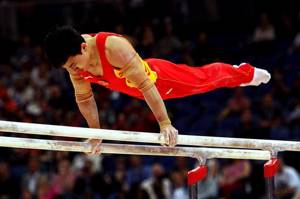
How to pump up your chest on the uneven bars?
Perhaps, parallel bars are the most effective way to thoroughly work out the muscle mass of the chest area. Push-ups on parallel bars are particularly simple, but the following conditions must be met:
- Before you start pumping up your chest on the uneven bars, you need to thoroughly warm up and warm up your muscles;
- before performing the next approach, you should rest for a few minutes, trying to completely relax the muscles;
- For chest pumping to be effective, the distance between the crossbars should be slightly greater than the width of the shoulders;
- to achieve noticeable results, you should exercise regularly;
- to avoid injury, you should ask a specialist about how to pump your chest on the uneven bars correctly;
- the number of repetitions in each approach should be at least 10-12 lowering and lifting.
Advantages and disadvantages
Like any other physical exercise, dips have their advantages and disadvantages. The main advantage is high efficiency, and the disadvantage is the high likelihood of injury. This means that this exercise can only be done if there are no contraindications. If pain occurs during the process or your health worsens, you need to stop training.
The benefits of dips, which are a basic exercise for all types of bench press, are obvious:
- effective training of certain muscle groups;
- promotes broadening of the shoulders, drawing of the relief, increasing the volume of the delta;
- helps develop athletic posture;
- increases muscle mass.
Despite the obvious benefits, there are some disadvantages:
- good physical fitness is required to perform dips;
- There is a heavy load on the shoulder joint, which often leads to injury.
However, in the absence of contraindications and following the correct technique, the likelihood of injury can be minimized. As a result, the exercise will be extremely beneficial.
Pumping triceps on parallel bars
To pump up your triceps on the parallel bars, you need to use the correct technique. The distance between the parallel crossbars must necessarily exceed the width of the shoulders, but only slightly. When performing parallel bars exercises with too much distance, there is a significant risk of injury to the shoulder girdle.
Triceps training on parallel bars begins with a position on straight arms. Next, the arms are lowered to the bottom position until the angle of the arms is about 90°. This is followed by a smooth rise to the starting position without unnecessary jerks. This is how the outer and medial heads of the triceps are effectively worked out.
In static exercises - all the strength
There are parallel bars exercises that are more effective if performed statically rather than dynamically. That is, do not wave your arms or legs, but, having taken one position, stay in it for a certain time. Such exercises include “Corner”. Having straightened your legs straight, you need to lift them up, bringing them to parallel with the floor. The angle between the body and legs should be 90 degrees (a right angle, hence the name of the exercise). In the first days of training, you should try to hold your legs for at least a few seconds. And then the time range needs to be gradually increased.
The gymnastic exercise “Plank on uneven bars” is also classified as static exercise. It is used on a full-size simulator, where it is possible to lie down on the parallel bars with the entire length of the body. Face down, legs extended straight, toes resting on the bars. Gently pushing your body up, straighten your arms at the elbows, keeping your back straight. In this position, in addition to push-ups, you can also stand statically. As with the “corner”, it only takes a few seconds for beginners to give up.
Weight training
Only parallel bars can completely replace the chest press.
What such exercises do has already been described above. In order for parallel bars training to become a basic exercise for working the core muscles, you should work with some weights. You can secure the loads on a special belt to the lower back, each time using more and more significant weight. Before you begin weight training, you should work hard to perfect the technique of performing the necessary exercises. It is also extremely important to select the most comfortable grip.
Triceps work
For pumping the triceps muscle, a narrow arrangement of bars, ideally shoulder-width apart, is best suited.
The technique is as follows:
- Keep your body straight, trying not to lean forward;
- Bring your elbows as close to your ribs as possible;
- Lower yourself to a right angle; if lower, the load will go into the chest;
- Do not straighten your arms at the elbows completely.

When doing this, try to mentally concentrate on your triceps; if you don’t feel them tense enough, it means you’re doing something wrong.
Particular attention should be paid to additional weights.

The elbow joint, which itself is easily susceptible to injury, takes on a greater load. If you experience the slightest pain, you should definitely reduce your weight.
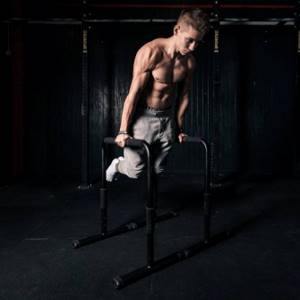
Recovery
Every experienced athlete knows how important the recovery process plays in the process of growing muscle mass and achieving high results. If we talk about training on the uneven bars, experts recommend doing it no more often than every other day.
In order to thoroughly pump the muscles of the chest area, during the recovery period you should provide the body with a sufficient complex of nutrients and microelements useful for the development of muscle mass, while not forgetting about complete relaxation. By following all the above tips, you can get a really well-developed and attractive torso, beautiful pumped up arms, and clearly visible abdominal muscles without any extra work and grueling training.
Work on the pectoral muscles
For chest training, parallel bars slightly wider than shoulder width are suitable.
To shift the load from the upper chest to the lower, you need to tilt your body forward as much as possible, while spreading your elbows wide, and lowering yourself as low as possible, feeling the stretch. Keep your shoulder blades down and don't round your shoulders.
Since the pectoral muscles are quite large and durable, the number of repetitions can be increased to 15, and the break between sets can be reduced to one minute.
But only if the exercise is performed correctly, otherwise you can overload the stabilizer muscles, which can lead to tears.

Push-ups
To transfer the load with minimal risk to the joints to the chest area, you need to move your elbows not back, but at an angle of 30-45 degrees. At the same time, tilt your chin to your chest and pull your knees towards you.
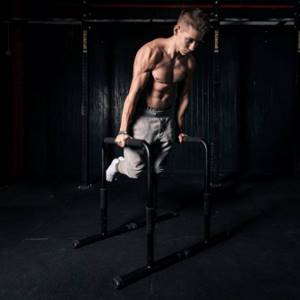
The depth of immersion will be greater than with triceps exercises, this is due to the fact that the increased amplitude will have a greater effect on tissue growth.
Relief development
Not all athletes set themselves the goal of increasing muscle mass. For many, endurance and drawing are more important.
The parallel bars training program for relief involves a large number of repetitions with your own weight.
The nature of training in this case will be determined by the specific goal of the athlete.
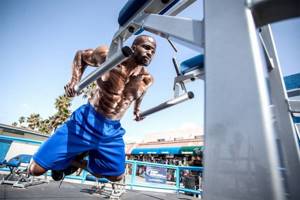
If you need to dry out in general, reduce the subcutaneous fat layer as much as possible so that the muscle relief becomes clearly visible, then the entire training process will be built on an aerobic principle.
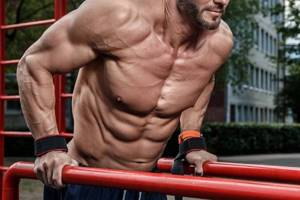
You sweat, you feel an overload of the respiratory system - it means you are doing everything right, the excess weight is gone.
Exercises on parallel bars are very energy-intensive by default, so they are perfect for this purpose.
The main thing is not to cross the fine line, from which, along with getting rid of fat, the body begins to burn muscles.

To avoid this, just follow the following recommendations:
- Let the body rest, all the main processes occur during sleep, as a response to the work done during the waking period;
- Take cortisol blockers, the so-called “stress hormone” that destroys muscles, for example, ascorbic acid is available and safe;
- Do not consume fast carbohydrates (sugar) before training; the body will not begin to use fat as energy while the blood is saturated with glycogen;
- Avoid alcohol, nicotine and junk food.
But sometimes it happens that there are no problems with excess weight, and the athlete is simply dissatisfied with individual muscles and even bundles of muscles.
In this case, isolation training will be useful. All muscle groups listed in the article can be improved to overall body condition in a targeted way.

One cannot ignore the so-called plyometric exercises, on the basis of which the increasingly popular CrossFit culture is based.
Their essence lies in the fast and explosive execution of repetitions, when at the end point of the amplitude the body hangs in the air for a moment.
Dilute your weekly parallel bars training program with plyometrics, and your efficiency will increase significantly, your circulatory system and heart will be strengthened.

Safety Tips
In order not to overshadow your activities with injuries, be sure to follow the following precautions:
- Check the projectile for strength and stability.
- Do not use bars where one pipe is higher than the other.
- When training outside in rainy weather, wear gloves with a grippy surface. If you slip while under load, you can get a serious sprain or simply fall painfully.
- Jump off the bars carefully.
- Watch for pain in your joints and ligaments. It’s better to skip a few workouts to recover than to say goodbye to the sport later.
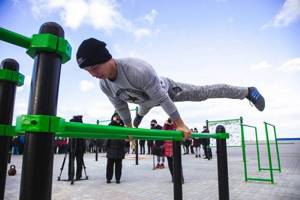
All this will help you make steady progress and get only pleasure and benefit from your classes.

